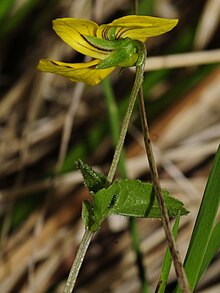Two-flowered violet
| Two-flowered violet | ||||||||||||
|---|---|---|---|---|---|---|---|---|---|---|---|---|

Two-flowered violet ( Viola biflora ) |
||||||||||||
| Systematics | ||||||||||||
|
||||||||||||
| Scientific name | ||||||||||||
| Viola biflora | ||||||||||||
| L. |
The two-flowered violet ( Viola biflora ), also called yellow violet or yellow mountain violet , is a species of the violet ( viola ) genus . It is common in the mountains of Eurasia .
description

Vegetative characteristics
The two-flowered violet is a grassy, hibernating green, perennial herbaceous plant that reaches heights of about 5 to 20 centimeters. The clearly developed, upright, thin, bald stem is unbranched.
The alternate leaves arranged on the stem are clearly stalked. The simple, scattered hairy leaf blades are kidney-shaped with a width of up to 4 centimeters. The short stipules are lanceolate and entire.
Generative characteristics
The flowering period extends from May to July. Each stem ends with a flower or two. The flower stalks are once or twice as long as the next leaf. The hermaphrodite flowers are zygomorphic and five-fold with a double flower envelope . The five sepals are pointed. The corolla is about 15 millimeters long. Of the five yellow petals , four are directed laterally upwards and, like the lower one, have brown streaks.
On an upright stem stands a bald, pointed, loculicidal, three-lobed capsule fruit .
The number of chromosomes is 2n = 12.
ecology
The two-flowered violet is a perennial hemicryptophyte . The vegetative reproduction takes place through underground runners . This delicate plant only thrives in protected, moist areas. It wilts quickly in the blazing sun, as the roots develop little suction. This plant has only a low need for light and, together with the nettle , the stinking cranesbill and the alpine rockcress, is one of the flowering plants that venture farthest into alpine limestone caves.
The two-flowered violet needs a thick blanket of snow to protect against frost in winter because it cannot tolerate temperatures below –12 ° C.
The two-flowered violet has the shortest spur of all violet species. This makes flies particularly suitable as pollinators . Also coming cleistogamous flowers against the already-pollinate in vernation itself.
The seeds are not spread by ants , as is the case with most violets , but mainly by deer , goats and chamois .
Occurrence and site conditions
The two-flowered violet is widespread in all mountains of Europe , Asia and the arctic region. As a location, freshly seeped to seeped moist, nutrient-rich and alkaline-rich, mostly calcareous, mild-neutral, humus clay or stone rubble soils are preferred in humid locations from the valley to at altitudes of 3000 meters. It is a character species of the Betulo-Adenostyletea class, but also occurs in high-montana societies of the Fagion or Alno-Ulmion associations. In the Allgäu Alps in Bavaria, it rises on the north ridge of the Kratzers up to an altitude of 2200 meters.
Systematics
The first publication of Viola biflora was in 1753 by Carl von Linné . Viola biflora L. is the only European species that belongs to the subgenus Viola subgen. Dischidium (Ching.) Petermann in the genus Viola .
use
The two-flowered violet is occasionally cultivated as an ornamental plant in the undergrowth of low trees.
supporting documents
literature
- Xaver Finkenzeller, Jürke Grau: Alpine flowers. Recognize and determine (= Steinbach's natural guide ). Mosaik, Munich 2002, ISBN 3-576-11482-3 .
- Manfred A. Fischer, Wolfgang Adler, Karl Oswald: Excursion flora for Austria, Liechtenstein and South Tyrol . 2nd, improved and enlarged edition. State of Upper Austria, Biology Center of the Upper Austrian State Museums, Linz 2005, ISBN 3-85474-140-5 .
- Konrad Lauber, Gerhart Wagner, André Michel: Flora Helvetica. 2nd, revised and improved edition. Paul Haupt, Bern 1998, ISBN 3-258-05735-4 , p. 308.
- Viola biflora L., two-flowered violet. In: FloraWeb.de.
Individual evidence
- ↑ a b c Erich Oberdorfer : Plant-sociological excursion flora for Germany and neighboring areas . With the collaboration of Angelika Schwabe and Theo Müller. 8th, heavily revised and expanded edition. Eugen Ulmer, Stuttgart (Hohenheim) 2001, ISBN 3-8001-3131-5 , pp. 672 .
- ↑ a b c d Ruprecht Düll , Herfried Kutzelnigg : Pocket dictionary of plants in Germany and neighboring countries. The most common Central European species in portrait . 7th, corrected and enlarged edition. Quelle & Meyer, Wiebelsheim 2011, ISBN 978-3-494-01424-1 , p. 842-843 .
- ↑ Erhard Dörr, Wolfgang Lippert : Flora of the Allgäu and its surroundings. Volume 2, IHW, Eching 2004, ISBN 3-930167-61-1 , p. 237.
- ↑ DH Valentine, H. Merxmüller, A. Schmidt: Viola L. In: Thomas Gaskell Tutin u. a .: Flora Europaea . Volume 2, pages 270-282. Cambridge University Press 1968.
Web links
- Two-flowered violet . In: BiolFlor, the database of biological-ecological characteristics of the flora of Germany.
- Profile and distribution map for Bavaria . In: Botanical Information Hub of Bavaria .
- Viola biflora L. In: Info Flora , the national data and information center for Swiss flora .
- Distribution in the northern hemisphere from: Eric Hultén, Magnus Fries: Atlas of North European vascular plants. 1986, ISBN 3-87429-263-0 at Den virtuella floran . (swed.)
- Thomas Meyer: Data sheet with identification key and photos at Flora-de: Flora von Deutschland (old name of the website: Flowers in Swabia )
- Data sheet with photo and distribution in France at Tela Botanica .


